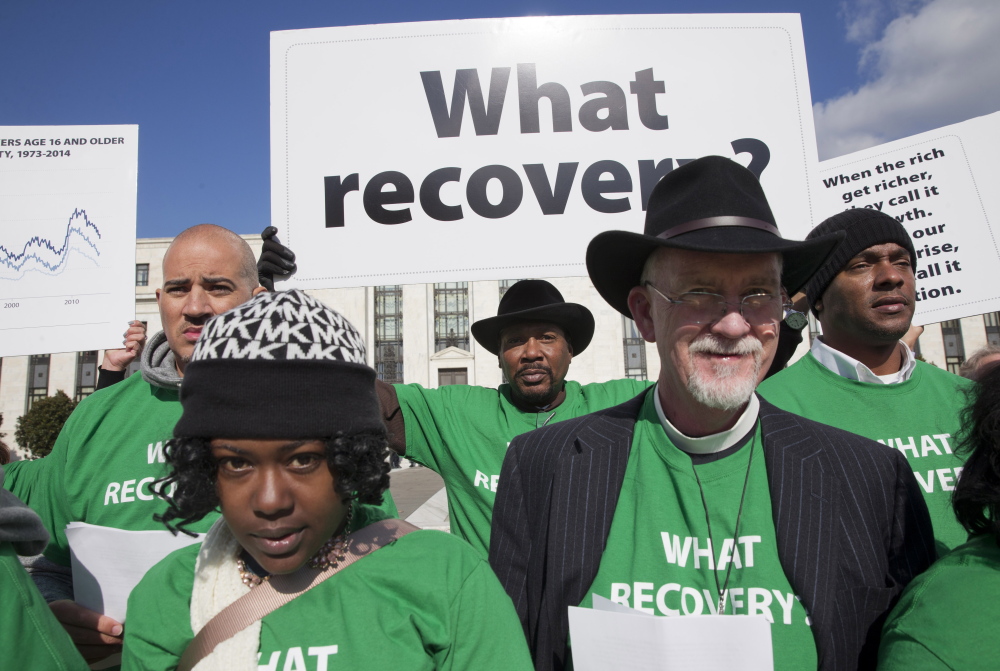The economy turned a corner last year, hitting, by a variety of measures, its highest levels since at least the beginning of the Great Recession.
The gains of the recovery, however, are going almost exclusively to those at the top of the economic ladder. That has led to a growing gap between the very rich and everyone else – really, an acceleration of a trend that has been occurring since the 1970s – that has consequences throughout American life. Put simply, as the gains of growth bypass most households, so too do the hopes of upward mobility and a solid middle class.
With a growing economic pie, that doesn’t have to be the case.
In the last year, the U.S. economy added 2.7 million jobs, the most since 1999, and unemployment is low. In December, consumer confidence hit its highest point since 2007, while a measure of business confidence by Moody’s Analytics reached its highest levels in the metric’s 11-year history. The S&P 500 recorded double-digit gains for the second straight year.
But while the income for the wealthiest 1 percent of Americans grew 31 percent from 2009 to 2012 – the latest year of available data – it rose only 0.4 percent for everyone else.
In fact, median family income, when adjusted for inflation, remains well below the peak of January 2008, the first time that has happened during what has been technically regarded as a recovery. Considering the enormous gains by the richest Americans, that means many others are experiencing stagnant incomes, or worse. Indeed, according to Pew Research Center, the gaps between upper-income families and middle- and lower-income families are at their highest levels in the 30 years that the group has been keeping track, and the top 0.1 percent of households now take up 22 percent of U.S. wealth, up from just 7 percent in 1979.
A look at the state of traditional industries throughout Maine shows just why this is happening. Productivity gains, a growing world economy and the rise of service-sector jobs are holding back wage growth and pushing jobs elsewhere. That has continued during the latest recovery, when the jobs that were gained paid 23 percent less than the jobs that were lost during the recession, accounting for $93 billion in lost wages, according to the U.S. Conference of Mayors.
Couple that with the rise of the financial and tech sectors, where wealth can amass and multiply, and you have a recipe for inequality.
The ultimate impact of this inequality is hotly debated. But there is certainly evidence that it makes the poor less healthy, hands more power and political influence to the wealthy and away from the issues that affect people with lower incomes, and contributes to economic and social instability.
Most alarmingly, wealth and income inequality reduce financial mobility, pulling the rungs of the economic ladder further apart and making it more difficult for Americans to pull themselves up in the way that has been so central to our country’s story.
That cannot continue unabated if the United States is to fulfill its promise of opportunity and prosperity. If 2014 is remembered as the year when the economy finally rebounded, then let’s hope 2015 is the year when the benefits began reaching more than just the richest Americans.
Send questions/comments to the editors.



Success. Please wait for the page to reload. If the page does not reload within 5 seconds, please refresh the page.
Enter your email and password to access comments.
Hi, to comment on stories you must . This profile is in addition to your subscription and website login.
Already have a commenting profile? .
Invalid username/password.
Please check your email to confirm and complete your registration.
Only subscribers are eligible to post comments. Please subscribe or login first for digital access. Here’s why.
Use the form below to reset your password. When you've submitted your account email, we will send an email with a reset code.